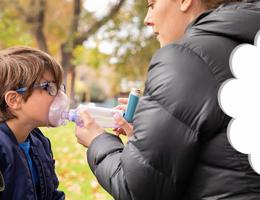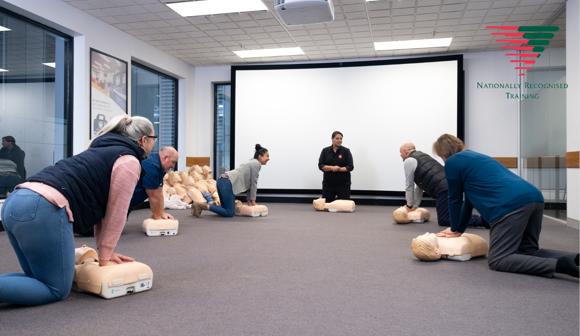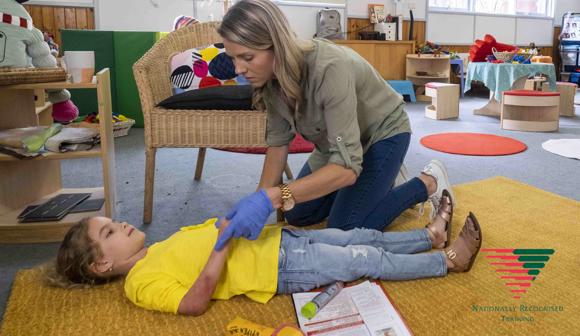Asthma First Aid – What Everyone Should Know

Are you one of nine (2.7 million) Australians who suffer from Asthma? Or do you have a close friend, family member or colleague who suffers from the common chronic condition? Chances are that if you don’t suffer from asthma you’re likely to know someone who does.
Follow our tips on how to manage and provide asthma First Aid to ensure you’re ready when an asthma attack strikes.
What is Asthma?
Asthma causes the air tubes of the lungs (bronchi) to tighten and tremble. This prompts excess mucus to be produced which causes difficulty breathing.
Sufferers of the chronic condition may uncontrollably gasp for air, cough and report tautness in the chest when experiencing an asthmatic episode.
For those who are fortunate enough to have never suffered an asthma attack, imagine your lungs constricting, limiting access to air and not being able to breathe no matter how hard to you try. Asthma is a serious condition and an acute episode can be a traumatizing experience for sufferers.

Signs And Symptoms
- Inability to breathe sufficiently
- Increasingly anxious causing a passive or alarmed state
- Focused purely on breathing properly
- Coughing, wheezing
- Onset of paleness and/or sweats
- Onset of blueness around the lips, ear lobes or fingertips
- State of unconsciousness

Common Asthma Myths
Despite the fact that 2.7 million Australians have asthma, many myths persist about what asthma is – or isn’t – and how it should be treated. Let’s address some of these common myths and misconceptions which can impact the health and day to day lives of people with asthma.
Myth: Asthma sufferers should not exercise
Truth: When asthma is well controlled, you can exercise and perform top sport
Myth: You need to have a wheeze for it to be asthma
Truth: Many people don’t experience wheeze as a symptom
Myth: Asthma is a childhood disease, individuals will grow out of it as they age
Truth: Asthma can occur at any age
Myth: Asthma is only controllable with high dose steroids
Truth: Asthma is most often controlled with low dose steroids
What Happens When An Asthmatic Is Exposed To Triggers?
Exposure to potential triggers may initiate inflammation in the airways which cause excess production of mucus. If this happens the person is likely to show signs such as wheezing, shortness of breath and coughing.
If not all symptoms are present it does not mean the person is not suffering from an asthmatic episode. The degree in which someone suffers an asthmatic episode is influenced by the level of exposure to the irritant.
What To Do If You’re Diagnosed With Asthma
Asthma is a manageable illness with little hindrance to a sufferer’s everyday life. But, sometimes due to unforeseen circumstances, asthmatics can suffer an acute episode which can be life threatening if an action plan isn’t set in place.
Once diagnosed with asthma by your doctor, together you should create an action plan to prepare for asthmatic episodes of all degrees.
It’s important to try and identify what causes the onset of asthma for you. This will help you to assess and remove yourself from environments where you are exposed to triggers if necessary. But remember, some triggers cannot be avoided so all asthmatics must carry their inhaler with them at all times.
Asthma can range from mild to severe for many sufferers and some are fortunate enough to never experience a serious asthmatic episode. Severity of asthma can be defined by:

Management of an Asthma Attack
Follow our tips on how to manage and provide asthma First Aid to ensure you’re ready when an asthma attack strikes.
Unconscious Casualty
Follow DRSABCD.
Conscious Casualty
- Ensure the casualty is sitting upright and leaning forward
- Reassure the casualty and ensure they have access to fresh air
- Help with the administration of medication (remember 4:4:4)
- 4:4:4 = 4 puffs of an inhaler + 4 breaths after each puff + wait 4 minutes before administering more medication (for children)
- If the symptoms do not subside call triple zero (000)
- Administer 4:4:4 until medical assistance arrives or symptoms subside
Note: Children can only use the method 4:4:4
Adults can use the method 6:8:5 (if necessary)
- 6:8:5 = 6 puffs of an inhaler + 8 breaths after each puff + wait 5 minutes before administering more medication

Asthma is the 6th most common health condition in Australia and last year’s freak storm suggests that many Australians remain undiagnosed. So whether you’re a diagnosed asthmatic, know someone with asthma or currently have no connection to the illness, learning the warning signs and how to provide asthma First Aid is worthwhile knowledge to have.
Remember, the most important thing an asthmatic can do is carry their medication with them at all times. Even if you think you know what your triggers are in some situations they just cannot be avoided.
Asthma is a manageable illness but an acute episode can have deadly consequences if you are not prepared. Take the right steps, implement an asthma action plan with your doctor and always carry your medication with you to ensure you’re ready to combat an asthma attack at all times.
With Asthma being a common health risk, everyone should know how to treat an asthma emergency. Learn how to effectively manage and treat an asthmatic emergency with our bitesize interactive eLearning course.


PROVIDE FIRST AID
Learn how to manage a range of common first aid scenarios.

EDUCATION AND CARE FIRST AID WITH ASTHMA AND ANAPHYLAXIS
Designed to meet the needs of people working in the childcare and early childhood industry.

INFECTION CONTROL ELEARNING
Workplace infection control course completed online within 45 minutes.
